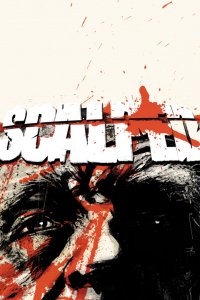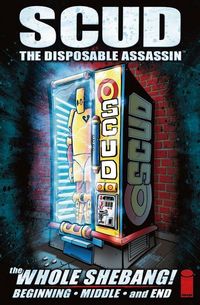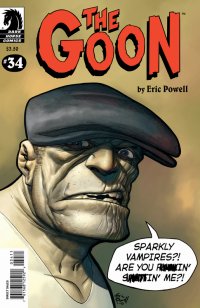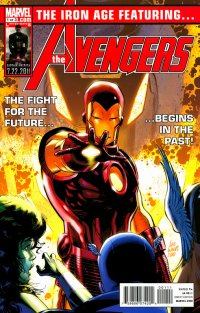Scalped #50 ($2.99, Vertigo Comics)
By Devon Sanders
I don’t use the words “sublime” every day but each and every time, I read an issue of Scalped, I honestly am thankful I’m a reader of comics. With Scalped #50, even more so. Writer Jason Aaron has crafted a near-perfect “jumping on” point for new readers while reminding longtime Scalped readers exactly why they want to be here. Issue 50 opens with “The Art of Scalping.” A dual and powerful tale of perspective set in the cold winter of 1876, masterfully drawn by series regular artist R.M. Guera. A second story, “The Art Of Surviving,” a tale of defiance set thirteen years later is brilliantly dialogued by Aaron and lushly illustrated by the vastly underrated Igor Kordey and a “Who’s Who” of a few of comics’ greatest artists such as Jordi Bernet, Jill Thompson and Steve Dillon. 50 issues in and now more than ever, Jason Aaron and crew show why Scalped is as vital and as thoughtful a piece of writing as anything going. Do yourself a kindness. Go read Scalped.
Rating: 




Out of a Possible 5 Stars
 Scud The Disposable Assassin: The Whole Shebang (Image, $29.99)
Scud The Disposable Assassin: The Whole Shebang (Image, $29.99)
by Graig Kent
Every now and then you read something that makes you think “wow, I’ve never seen anything like this before”, a rare comic book specimen that sizzles with synaptic stimulation, as if pure creativity and entertainment combined on the page. Yes, it is a rare occurrence, but it’s a fair shake more rare when you re-read something and have the same reaction (… yoy know, because you have seen it before).
I originally came across Scud in the mid-1990’s as I scoured the pages of the monthly Previews catalog (from which retailers order their comics and other merchandise two months in advance). I remember vividly the cover to issue three, featuring a skinny, improbably held-together robot lofting a gun three times it’s size. Moreover what caught my eye was the retro Tide detergent-looking logo for the book. Like “Buffy The Vampire Slayer”, “Scud The Disposable Assassin” tells you almost as much as you need to know about the series to decide whether you’re going to get hooked or not.
I was hooked.
I followed Scud as best as I could for a sporadically published indie press comic in its early years. The first ten issues of my collection were incomplete but by the time Scud hit its tenth issue it was a modest indie success, with the character joining the ranks of Hellboy, Madman, Milk & Cheese, and a scant few others as icons of the ’90’s alternative (to superheroes, natch) comics.
Scud‘s allure was two-fold: a simple premise and a highly off-beat, comedic sensibility. The premise: in an alternate earth to ours (where mutants, monsters, cyborgs and aliens all co-exist in a fractured reflection of our society) one can buy a Scudco brand assassin robot from a vending machine, give it a target and it will take care of it, promptly self-destructing thereafter. This is the story of one of those robots who discovers its fate and instead of killing its target, puts it on life support and now must take other freelance assassin gigs to pay the hospital bills. By that description alone you can see where the humor is, but scud isn’t an outright comedy — though it is frequently very funny — it’s a frequently insane action-adventure that invokes pop culture and embraces nerd culture (and, in context, at a time where this wasn’t yet a trend or the norm), yet not in parody and definitely not its focus.
Beyond the often relentless action and borderline inconceivable world of Scud, there’s a character drama laying underneath the surface, never overtly rearing its head (at least not in the early goings) but it is there, as Scud explores his identity and sense of self (and self awareness) a little in every issue, learning to grow beyond programming and adapt to society in a way Scudco never intended.
Scud The Disposable Assassin was optioned by Oliver Stone for a feature animated film in the late-’90’s, which, like so many other comic-to-film options over the years, never materialized into reality. The option, however, brought Scud creator Rob Schrab, and co-writer Dan Harmon to Hollywood, where they sold their script for Monster House, developed the infamous Channel 101, created the legendary failed Jack Black tv pilot Heat Vision and Jack and The Sarah Silverman Program (with Harmon now most notable for creating Community). In the move to Hollywood some things got lost. Scud was one of them.
Issue 20 in 1998 was the last we would see of Scud until Schrab would pick the character up again 10 years later, now at Image, finishing off a final arc for the book. I admit, at the time, the magic felt lost to me. The time had passed for Scud and this latter day revisiting did nothing for me. The magic wasn’t lost, however, just forgotten, (as I had passed all my issues along to a friend in the intervening years and thus had no reference to look back upon) all of which came flooding back reading “The Whole Shebang”.
It’s a thoroughly entertaining work with moments of utter brilliance. Schrab’s art takes some getting used to (as he develops and modifies his cartooning style throughout) but it’s very rarely misunderstood and his action choreography is as impressive and insane as his character design (just take a look at Jeff, Scud’s first target, with an electrical plug for a head, mousetraps for hands, arms for legs with mouths at the elbows, and a squid double-belted to her chest).
Scud is an experience, to be sure and, in my experience, an even better one the second time around.
Rating: 




Out of a Possible 5 Stars
The Goon #34 (Dark Horse, $3.50)

By Jeb D.
Has Eric Powell learned nothing from his time slumming at DC? When you have a comic returning from an extended hiatus, you rebrand it with a new #1 (including lots of banners, callouts, and attendant press coverage). That way, those people whose principal interest in comics is the brand name on the cover, and the issue number, rather than the contents (evidently a fairly large group), will make a Pavlovian move for their wallet. Instead, this Powell bonehead has put all his effort into creating a first-rate piece of comic entertainment–what line of work does he think he’s in?
For the converted, it’s simple: The Goon is back. He is not “bigger and better than ever,” there’s no attempt to up the ante from previous heights. In fact, in many ways, this is one of Powell’s simplest, most straightforward Goon stories yet. And it’s just wonderful.
For those not yet infected: The Goon is probably the funniest, and quite possibly the most beautifully-illustrated, book on the stands today, with a sensibility inherited from the original Mad Magazine and old EC horror comics. Writer/artist Eric Powell has created a ramshackle, run-down world (it’s like a weird cross between The Spirit’s Central City and Pogo’s Okefenokee Swamp) inhabited by ghouls, zombies, and bug-eyed monsters of every description, and when the (not particularly) innocent denizens are bothered by one of said nasties, they call upon The Goon: a hulking ex-hoodlum/enforcer with a heart of gold… but of the 14K plated variety: catch him in a bad mood or on a bad day, and he ain’t savin’ your ass. But when he’s so moved, he’ll wade in against Powell’s menagerie of freaky menace and hand them their heads in some of the most giddily entertaining action scenes you’ll find anywhere.
Though Powell has created a backstory for The Goon, and tried his hand at a full-scale graphic novel with the character, issue #34 is a fairly typical done-in-one Goon story, with our hero too busy watching football on TV (his beloved Fish-Canners finally win a game!) to help the local urchins who are having problems with the disturbing new girl in town. Does The Goon finally come to their aid because he realizes it’s the right thing to do? You must be joking: the kids have to get him drunk before dragging him off and tossing him in against one of Powell’s more visually imaginative monsters. There’s also some snarky, cheap pop-culture jokes thrown in (and Powell wisely uses them as nothing more than a curtain-raiser, rather than going for some kind of strained extended riffing), and the usual hilarious banter between The Goon and his wonderfully appalling partner Frankie. My only reservation about this issue, frankly, is the cover: not only would it mislead readers that the main story is an obvious Twilight parody, but it’s also weird whenever we see The Goon’s eyes not hidden by his pulled-down cap; Powell usually reserves that for an emotional beat that isn’t quite earned here.
There’s not that many comics out there now that consistently reward your purchase, issue after issue, and since two of them came out this week (The Goon and the 50th issue of Scalped–see above), this week may prove to be the high water mark for comics in 2011.
Rating: 




Out of a Possible 5 Stars
 The Iron Age Featuring… The Avengers #1 of 3 (Marvel, $4.99)
The Iron Age Featuring… The Avengers #1 of 3 (Marvel, $4.99)
By Jeb D.
The trick with time-travel stories is not sorting through all the contradictions and impossibilities inherent in the form, but giving the story an emotional heart that allows it to transcend (or at least downplay) the chronological inconsistencies. While this is often in the form of doomed romance (Time After Time, Bid Time Return aka Somewhere in Time, etc.), regret and dark introspection can also be workable story engines, and writer Christos Gage plays that card pretty decently in this issue.
Tony Stark’s been sent off (in the preceding Iron Age: Alpha) on a time-quest to get bits of Dr. Doom’s time machine to fix a world that he helped screw up/destroy (but since this is about time travel, did either of those things actually happen?). His first stop? The penthouse apartment of a sloshed, useless Tony Stark during his “Demon In A Bottle” period. Not terribly worried about two Starks occupying the same space, Gage instead focuses on the terrible clarity of remorse as Tony sees, for the first time, the horrible mess his drinking made of himself and those around him… and the fact that, even now, he can still feel alcohol’s pull in times of stress. Forced to impersonate his contemporary self, Tony goes to The Avengers for help, to find himself devastated at coming face to face with the young and very much alive Jan Pym… and at coming face to face with teammates that don’t trust the alcoholic they believe him to be; thus does the typical superheroes-misinterpret-each-others’-motives fight ensue. And that’s just the beginning of Tony’s troubles, as Gage neatly stacks the deck against the Armored Avenger with old friends and foes.
For this kind of storytelling, it’s old school all the way, and Lee Weeks and Tom Palmer knock it out of the park: it’s like reading a classic Avengers book by someone like John Buscema. Gage also captures the pacing and dialog of that simpler, heroic time (even to having the various team members spout exposition as they join in the fight).
The second half of the comic moves the story on with Tony finding himself in a bleak, alternate London, with a bitter and dismissive Captain Britain as his only ally in his quest to put time to rights. Rob Williams’ script, and Ben Oliver’s art (with colors by Veronica Gandini) is much more in today’s grim n gritty vein (it reminds me of a less precise Adi Granov), but its imaginative design choices and punchy storytelling pull things out on a winning note (though the too-tidy presentation of the terrible choice Tony has to make drags the ending down a bit).
It’s always hard working up much investment in these world’s-gonna-end stories, since we know that it won’t (so long as there is ancillary marketing money to be made); the only way to really dig into one is to have a price exacted from your central character, and so far, this series more or less succeeds there: though we know the eventual end of Tony’s quest, the creative teams here at least make the journey a harrowing one for him.
Rating: 




Out of a Possible 5 Stars